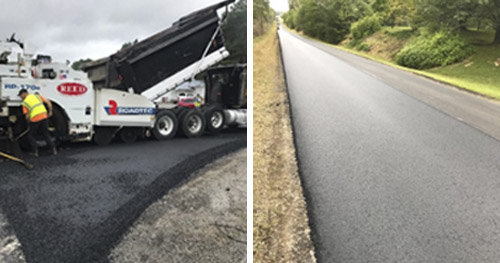Reed Contracting of Hollywood, Alabama, paves first Evotherm project
Jul 09, 2019
Do you remember your first experience using Evotherm? We welcome Reed Contracting to the Evotherm fray after their first project using Evotherm in Alabama. Reed’s 500-ton test strip along CR 20 near Huntsville, Alabama, was a success. With the test strip situated roughly 50 miles from the plant and haul times up to 75 minutes, Reed saw how helpful Evotherm can be for a mix.
On an overcast, 73 F day in October, what, exactly, was Reed looking for when using Evotherm?
“I wanted passing TSR results,” said Jason Hill, quality control manager at Reed. “Before Evotherm, we were getting results in the low 0.7 range. With Evotherm, we were easily able to pass the minimum of 0.8 and saw results from 0.85 to over 0.9. I also wanted better density and compaction results. We saw density numbers over 95%.”
Reed’s mix design called for a 12.5 mm surface mixture with 20% RAP and 25% slag. Evotherm M1 was added at the plant. The dosage rate was 0.3% for the first 250 tons and then 0.4% for the rest of the mix tons. The binder was a PG 67-22. Reed began producing their Evotherm mixture around 335 to 340 F and were ultimately comfortable dropping temperatures down to 315 F.
The crew used a Roadtech RP-170e paver and Cat rollers on the job. The rolling pattern was two vibratory and two static passes followed by the finish roller.
There was no shortage of praise for the product from the crew on the jobsite. The paving foreman liked the workability of the mix, and at one point, Jake Mount, a technician on the job, was overheard commenting: “Evotherm, I love this stuff!”
After a successful first run with Evotherm, what are Reed’s plans for the future?
“I’d like to try Evotherm in our commercial mixes,” said Hill. “Particularly, I’m interested in how it can help workability and the overall look of the finished products. I’m also interested in how Evotherm performs in the summer at lower temperatures and how it can help with paving in colder temperatures.”

